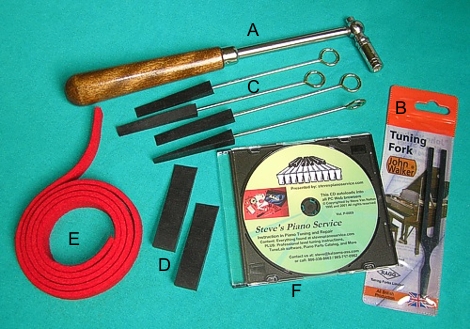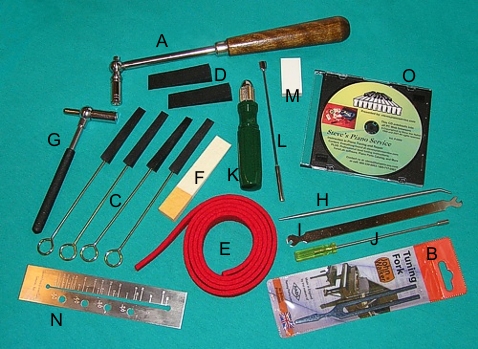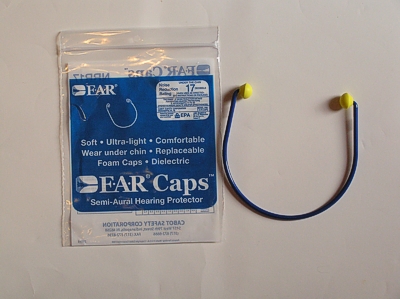| STORE
HOURS 9 TO 6 CDT GMT minus 5 hours Monday thru Friday (800) 338-8863 1 (906) 864-1437 |

PIANO TUNING TOOLS AND KITS
The
tools we sell are not flea market quality.
I was asked to carry a line of Chinese
tools by the manufacturer.
I examined samples, and they were typical--
Machining
was poor, steel blackened with age, and they
showed that piano technicians
did not design them.
You can save a bundle on the Web by hunting for Chinese
junk.
To you
who want quality, welcome.

| ORDERING INFORMATION: MINIMUM
ORDER: SHIPPING
POLICY: You MUST browse the Catalog area, and try to learn what you want. We no longer search our catalog for you. Have
this information ready: Make
sure you are in the catalog area for your kind of piano-- If you are confused, call us for assistance. If
we do not answer the phone, we are probably here-- Just leave a message- we will
return your call (it may not be the same day). |
There are some jobs that require the right tools. Piano
tuning is
one of them. I have seen the tuning pins after someone tried
to
tune a piano with vice grips or an inverted quarter inch socket.
The point is not only the botched job of tuning-- Often the pins
are ruined
and have to be removed and replaced-- VERY costly!
Don't try to improvise unless I have told you how in the online book chapters.
For
all parts possible I give you a diagram identity number so you can go to
the Diagram and double check to see if you are
ordering the right part. It is
impossible to give a "Back" button to
return from so many links, so please
use your browser's "Back" button.
Also,
I give you a link to the page which tells how to make the repair or
installation
of the new part.
|
How we help you better: Keith has over 35 years experience as a piano tuner-technician and rebuilder. Keith is on hand helping fill orders and answering the phone. When
you buy a tool kit from us, Read the online help area FIRST, and then call if you don't understand. No one offers a deal like this anywhere in the world. We WANT you to succeed, whether you live in Boston, Bangladesh, or out back of Bourke. |
SEARCH THE WHOLE SITE
This page contains the basic tools of the Piano Tuner / Technician. Perhaps you are specifically looking for.......
CLICK HERE-- To go to Piano Repair, Rebuilding,
Restringing, and Action Adjustment Tools....
(Or "REGULATION of the Action")CLICK HERE-- For the best selling Piano Tuning,
Restoration, and Repair Book for do-it-yourselfers....CLICK HERE-- For High End Hale and Schaff tools.
DO NOT go here for regular line tools-- they are below on this page.CLICK HERE-- Electronic Tuning Meters with and without built in
Temperament and Stretch
![]()
Why are our Tool Kit choices a bit complex?
First, we have found that most folks can figure out what we are doing here.
Second, every person has slightly differing needs. So, we want YOU to have options.
Virtually no one in this trade offers the mix and match method of building a tool kit like this.
So, get a cup of java, and spend some time. You will be able to get the very best combination
of tools to meet your needs.If you find this confusing and would like help making choices, SEND MAIL
OR, Call: (800) 338-8863 -- 9 to 5, Mon. to Fri.
Touch
Up Tool Kit
(No Regulating Tools Included):
Indicate
"Touch Up Tool Kit " on the order blank
or when ordering by phone.
 This
tool kit is for the person who wants to keep the piano in tune between regular
tunings.
This
tool kit is for the person who wants to keep the piano in tune between regular
tunings.
There are no regulating tools in this kit.
For regulation as well as tuning
tools see the next kit below.
Here are some reasons why to buy this kit:
1. You need to do a panic tuning and the piano tuner is not available.
This kit will be on hand and ready.
2. You have a piano tuner tune regularly,
but you simply want to clean up various notes which go out
due to weather or moving the piano.
3. You have notes where the tuning pins are loose and particular strings go out frequently.
4. A string broke, and you are replacing it yourself.
5. You have a studio and demand absolute perfection.
A professional tuning every week is out of the question financially.
6. Your piano has been restrung, and the strings need to be pulled up frequently
until they are seasoned.
| TOUCH UP TOOL KIT A.
1 Craftsman Tuning Lever TOTAL you pay $ 125.50 A savings over listed prices. |
|
ONLY
HERE: Customize your Touch Up Took Kit
We offer kit building
options which save on the regular price
while you make
your kit a more powerful tool of excellence.
Smart Tuning Lever Substitution:
Do you want to buy this Kit with a Better Tuning Lever?
You may substitute any of the following professional quality Schaff Tuning Levers
in place of the Craftsman lever shown in the above graphic. (Price shown is kit price with the upgraded lever.)Watenabe Extension Lever $ 383.00
Professional Lever, Black Nylon Handle $ 168.50
Deluxe Professional Lever $ 222.95
Add
a Tuning Meter to the above Touch Up Tool Kit--
The prices with tuning meters are a savings
over buying "by the each."
TOTAL with Korg CA-50 Tuning Meter with Temperament $ 177.50
Extra Clip On mic included- Tuning fork includedTOTAL Above kit with Korg OT-120M $ 264.50
Extra Clip On mic included- Tuning fork included
The MIC included is the Clip On Mic as in the illustration on the meter page.
Add
a Regulating Tool Kit
These
Regulating Kits will allow the novice tuner to do regulating
of piano actions.
If you add the Basic Regulating Tool Kit to the Touch Up Tool Kit $ 321.95
If you add the Master Regulating Tool Kit to the Touch Up Tool Kit $ 596.25
Add
PIANO SERVICING,
TUNING, AND REBUILDING
Third
Edition (latest printing)
By ARTHUR A. REBLITZ
The first edition of this world famous book has sold over 45,000 copies
and has become the classic manual for piano technicians and amateurs
internationally. Originally published in 1976, Piano Servicing has now
been updated and expanded, incorporating the experience of another
decade and a half of exacting service and restoration by the author.
Bibliography and index included, 8 1/2" x 11", and hundreds of illustrations.
Close to 300 pages of the best information available for the professional
tuner / technician. College textbook quality, but at trade prices.1678 Paperback-- This is the latest reprint of the most recent edition of this
book.Price of the book with the above Tool Kit Add $ 46.00
Price for this Paperback book alone Add $ 50.00
![]()
Standard
Tool Kit
Tune Your Piano and Regulate the Action
For Do-It-Yourselfers
and Professionals:
Simply
indicate "Standard Tool Kit " on the order blank
or when ordering by phone.
 This
tool kit will allow you to do your own repairs and tuning. I try, in
the online book, to help you make
This
tool kit will allow you to do your own repairs and tuning. I try, in
the online book, to help you make
nearly any repair that is needed. This
tool kit will be very valuable to missionaries and those in
international
communities where piano service is not available.
Music directors and
band masters in universities and Secondary Schools will also find this kit will
"save the day" from time to time.
We don't try to sell you any tools which you can buy at Ace Hardware or WalMart.
Descriptions and use of each tool are found on the CD we send with the kit.
| Standard Tool Kit A.
1 Craftsman Tuning Lever This kit is a considerable
savings over our |
|
ONLY
HERE: Customize your Standard Took Kit
a la carte
We offer kit building
options which save on the regular price
while
you make your kit a more powerful tool of excellence.
Smart Tuning Lever Substitution:
Do you want to buy this Kit with a Better Tuning Lever?
You may substitute any of the following professional quality Schaff Tuning Levers
in place of the Craftsman lever shown in the above graphic. (Price shown is the kit price with the upgraded lever.)Watenabe Extension Lever $ 633.00
Professional Lever, Black Nylon Handle $ 438.50
Deluxe Professional Lever $ 472.95
Add
a Tuning Meter to the above Standard Tool Kit--
TOTAL with Korg CA-50 Tuning Meter with Temperament $ 427.50
Extra Clip On mic included- Tuning fork included
TOTAL Above kit with Korg OT-120M $ 514.50
Extra Clip On mic included- Tuning fork included
The MIC included is the Clip On Mic as in the illustration on the meter page.
Add
a Regulating Tool Kit
These
Regulating Kits will allow the novice tuner to do regulating
of piano actions.
If you add the Basic Regulating Took Kit to the Standard Tool Kit $ 571.95
If you add the Master Regulating Tool Kit to the Standard Tool Kit $ 846.25
This kit will duplicate a couple of tools. We cannot adjust for that.
Add
PIANO SERVICING,
TUNING, AND REBUILDING
Third
Edition-- 2019 printing!
By ARTHUR A. REBLITZ
The first edition of this world famous book has sold over 45,000 copies
and has become the classic manual for piano technicians and amateurs
internationally. Originally published in 1976, Piano Servicing has now
been updated and expanded, incorporating the experience of another
decade and a half of exacting service and restoration by the author.
Bibliography and index included, 8 1/2" x 11", and hundreds of illustrations.
Close to 300 pages of the best information available for the professional
tuner / technician. College textbook quality, but at trade prices.1678 Paperback-- This is the latest reprint of the most recent edition of this
book.Price of the book with the above Tool Kit Add $ 46.00
Price for this Paperback offer alone Add $ 50.00
![]()
![]()
|
THE WORLD'S
BEST TUNING LEVERS These
levers are one of the lever options |
 ORDER BY PHONE WITH CREDIT CARD
ORDER BY PHONE WITH CREDIT CARD
Order by our Toll Free Number:
1 (800) 338-8863
OR:
Go to Mail Order Form for printing:
![]()
SPECIAL ITEMS WE OFFER
CD OF THE WHOLE SITE
Professional Tuning Instructions are only found on the CDClick Here to Order OR, ADD IT TO YOUR ORDER BY PHONE $ 18.00
1.
The whole piano site as you see it on the Web. Browse some more to
see what you get.
My book is nowhere else, nor is it
in print.
2. You get TuneLab 97. This is the complete program from Robert Scott
in Michigan.
It is ideal for a laptop, but it can be
used also in any IBM compatible PC.
3. You get my Music page with MIDI, WAV, and Real
Audio features just like it appears
on the Journal.
4. On the CD you get my professional piano tuning instructions.
These lessons are more complete than other professional courses
that I have found.
The language is plain. Humor
is sprinkled here and there.
And, I give away
many secrets to successful tuning and repair.
5. COST: $18 plus postage [ FREE with a $200 order ]
![]()
PIANO TUNING TOOLS
These tools are essential to do
a good tuning.
I try to give you a choice if you expect to do just
one tuning or many.
There are many other Piano Tool options on the market.
You may purchase them from other sources. Here, you have the advantage of
knowing that I have
either used the tools I sell, or I have researched them
with other old timers in the trade.
So, I do NOT list every tool available.
This is good for YOU, and it prevents returns :-)
| Part Description: Part Number Price Keyes Impact Tuning Lever from Schaff Piano Supply
|  |
Part Description:
Part Number Price
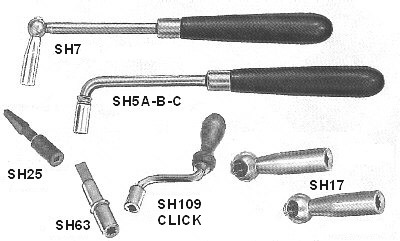

Tuning Lever for the Apprentice Tuner The head is removable,
and it accepts several attachments,
including the more expensive
levers
on the Shaff Page.
Lever is 11 inches long- 16229 in the illustration below
Hard wood handle-- One piece star head-tip
2 1/2 inches long, No. 2 tip
No substitutes
for the head choice of the initial lever.
You may buy other one piece heads below or "Hale" and Schaff style
tips to give other tuning configurations.
See below.
See graphic at lower
right and above
With one piece
Star Head
SH7
$ 73.75
Schaff
One Piece Tuning Lever Head / Tip Combination
Cannot be used
with other tips.
2-1/2 inch long, #2 star head, 5 degree angle
SH17
$ 28.75
2-1/2 inch long, #3 star head, 5 degree
angle
SH17-3
$ 28.50
2-1/2 inch long, #2 star head, 15 degree
angle
SH17-15 $
28.50
1-1/2 inch long, #2 star head, 15 degree
angle
SH17A
$ 28.50
4 inch long, #2 star head, 5 degree angle
SH17B
$ 33.75
5 inch long, #2 star head, 5 degree angle
SH17C
$ 37.50
Order the "Hale" style and Schaff style heads and tips for the Apprentice Lever
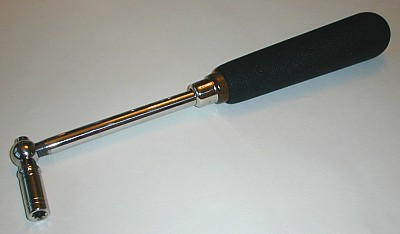 Craftsman
Lever
Craftsman
Lever
This is our suggestion
as the ideal lever for economy and quality.
You get the apprentice lever handle with the "Hale" and
Schaff style head and tip.
The threads
are the same on this lever and all professional levers we sell.
Later, you can add other tips and heads to meet special
tuning needs you may
encounter.
We feel this lever gives you maximum versatility with economy.
Tip is number 2 size (Part No. 14B)
The lever comes with a wood handle without the
foam grip seen in the photo.
Head
is short 1 1/4" head at 5 degree angle (Part No. 13G)
Part Number SH8
$ 102.50
Order the "Hale"
style and Schaff style heads and tips
for the Craftsman Lever
Tuning
Pin Extractor This 3/4 inch long tool (not shown in Illustration) will remove
a tuning pin which has been damaged by
amateur efforts to turn a tuning pin
with
improvised tools. It will also remove a pin which has broken off at the
hole. The tool fits into the tip of a tuning
lever. It has tapered reversed threads
so that, when turned counterclockwise, it bites the top of the broken pin
and
removes it. This is similar to
an "easy out" used in automotive applications on
broken engine bolts. It will seldom be needed, but when such
an emergency
transpires, this is
the ONLY thing to save the day. It should be in EVERY
professional tool kit. If the tuner before you did not have
one, this tool will
make you look
like his superior for sure. You will want to price the task to
pay for the tool the first time since you will seldom
use it.
SH110
$ 32.50
ADDITIONAL
TUNING LEVER TIPS AND HEADS
Power Tool Tuning Pin
Socket
For installing and removing
tuning pins with a power tool fast
16086
in illustration
SH63
$ 33.50
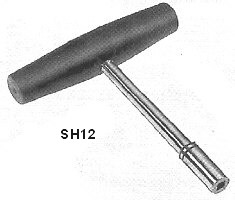 T-Stringing Tuning Lever
T-Stringing Tuning Lever
The finest T-Lever available
Tough alloy
steel and nylon handle.
Made for factory work, but tuners
can benefit.
The T-Lever will fit in the treble of a
grand piano without hitting the cabinet.
Carry along in small tool pouch
SH12
$ 40.95
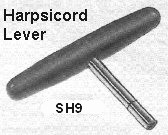

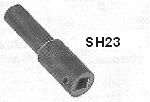
Harpsichord
Tuning Lever- "T" handle- Star head- 16235A in illustration
SH9 $
22.00
Ratchet head- Speeds up removing and driving in new tuning pins-
Use an automotive application 3/8ths
inch ratchet wrench--
Star head
(eight points for more choices of positioning)--
See Stringing Tools Page
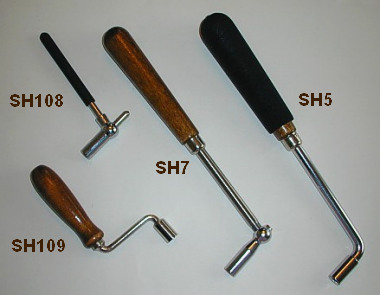 Pin
setting tool- Drive loose pins deeper into the pin block without losing
the
Pin
setting tool- Drive loose pins deeper into the pin block without losing
the
tension of the wire- The handle
cover is now more subdued than the one
in the illustration. See Pin Setting Tool at Right.
This tool comes with a foam grip.
[ Repair- Chapter
7, #60 ]
SH108 $ 58.50
Stringing
Crank For removing loose
tuning pins. --
Plastic handle on crank
instead of wooden ball, as in the graphic
Speeds up re-stringing of all pianos
SH109
$
36.50

Rubber Mute- Metal brass handle-
SH203 $
2.00
Rubber Mute- 6 inches by 1/2 inch-- Without metal handle- SH202 $ 2.25
Rubber
Mute- 4 inches by 1/4 inch-- Not in graphic
For the tight area between the dampers and bearing
bar on uprights SH201-1/2 $ 2.00
Rubber Mute for grand piano- 3 inches by 3/4 inch
Short, stubby, and wide-
SH205
$ 2.25
 Felt
Wedge Mute- White and gray mute (not hammer scrap) Fine cut-- Very classy
Felt
Wedge Mute- White and gray mute (not hammer scrap) Fine cut-- Very classy
Will not deteriorate over time like rubber,
but will slightly fluff with age to mute
better and better. I think these add a touch of class that black rubber
lacks.
Also, may be used in buffing
situations (key tops) with liquid compound.
3/4 inch wide by 4-1/2 inch long
SH206-A $ 8.50
1-1/2
inch wide by 3-1/2 inch long
SH206-B
$ 11.00
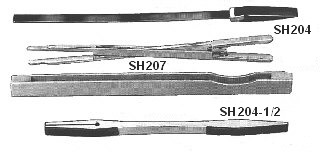
Treble Mute-- Split to mute the
middle string only. No longer has the
steel handle, but a brass one like the 203 mute.
SH204 $ 6.25
Papp's Treble Mute-- From England
Classic case of over-engineering--
I added plastic tape to the outside of
the jaws on mine and trimmed neat.
BUT, very useful to select which string you
want to mute--
SH207 $ 15.00
Split End Wood Mute-- Maple and buckskin covered working ends-- SH204-1/2 $ 11.95

Red felt temperament mute- Used to mute two octaves in the center
of the piano
when setting the temperament-
Also, mute the bass on grands with a second one.
This mute is tapered from 3/4 to 1/2 inch to help cross the treble
break-- SH209
$ 11.75
Two of the above felt temperament mutes-
$ 21.75
Above
mute-- tapered from 3/4 to 1/2 inch to help cross the treble break--
The difference in this mute is that it is thinner--
1/8 inch thick--
SH209T $ 11.75
Gang Mute- This fits into the temperament octave without having
to push felt between the wires. Saves
time, and easy to use.
You may want to cut
the tips shorter to avoid hanging up on the sound board
This mute is only practical with grand pianos. May be
modified with uprights.
SH 211 $ 12.50
Mason Hamlin Tuning Wrench For "Top Stringer"
PROTECT YOUR HEARING
After 23 years of tuning pianos I have suffered some hearing loss. I did not have any indication that this could happen when I started in the tuning trade. In recent years I have talked to several tuners who had the same experience. Other tuners have told me they use ear plugs to reduce the volume of sound to protect their hearing.Hearing protection must not interfere with hearing the beats and subtleties of sound. So, I have located a source for ear plugs which will reduce the sound level by 17 decibels. This is enough to take the force out of the loud pounding we need to do to set a string so that it will not move later.
I personally tested the ear plugs, and I was very pleased with the results. I could still hear all of the tone and sound features I needed in order to tune, but the pain was gone. I am so sorry I did not learn about this long ago.
These are not generic ear plugs, though I admit they look rather simplistic in the photo. They are tested and approved for safety purposes in the industrial world and are used in machine shops where mid level noise is a problem. Instructions are included to properly fit the ear plugs. They must be worn under the chin to be effective. This also gets them out of the way when working.
The yellow replacement plugs are available though our store.
Part Number-- SM5500 PRICE- $ 14.95
Pair of new yellow ear caps-- Part Number-- SM5501 PRICE- $ 8.50
May I say this.... ?
At our store we are constantly watching for new products, and crossover products,
which will make your tuning experience safer and more excellent. If you see a need
to solve some issue in piano related needs, SEND MAIL please.
TUNING FORKS
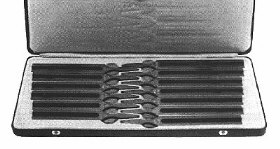
13 Tuning Forks Of a Chromatic
John Walker- Scale In Carrying Folder-
Sheffield forks imported from England,
and they cover the temperament octave
from C-261.6 to C-523.3.
They are made of blued steel, and are
packed in an attractive hard leatherette case with clasps. The note and frequency
of the note is clearly shown on each fork. SH2124 $ 445.00
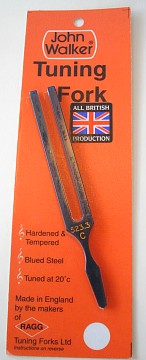
John Walker Tuning Fork-- 150 year old company
Made in Sheffield England By the Ragg family--
Sheffield Blued Steel- C-523.3 SH2111 $ 25.00
Same Tuning Fork-- A-440- SH2110 $ 25.00
Chrome Plated Tuning
Forks--
Made by John Walker of Sheffield,
England
These forks are large steel forks,
3/8" wide, which provide a long, loud ring tone.
The forks are chrome plated and come in a vinyl pouch. Approx. 5-1/2"
long.
Tuning Fork A-440
SH2106
$ 91.00
Tuning Fork C-523.3
SH2107 $ 91.00

Aluminum "Monster" Tuning Fork-
Milled from heavy aluminum alloy- 3/8ths by 1" by 6". This
is a bulky fork,
but the duration of tone
is exceptionally long and sweet.
A440-
SH2108 $
28.00
C523.3-
SH2109
$ 28.00
Strike
tuning forks on a padded surface.
Hitting metal with a tuning fork
can alter the pitch if the blow is harsh.
See Table
of ContentsChapter Seven,and
Appendix
One- Tuning Instruction for tuning fork use.
Find Action Adjusting tools
below the Tuning Meter section.

OTHER
REPAIR AND RESTORATION TOOLS:
TUNING PINS AND REPAIR TOOLS AND TUNING PIN TREATMENTS
TUNING METERS CLICK HERE
HIGH END TUNING LEVERS (HAMMERS) CLICK HERE
PIANO
REPAIR AND ACTION ADJUSTMENT TOOLS
(Or "REGULATION of the Action")
CLICK
HERE
LUBRICANTS,
PIN TREATMENTS, GLUE, STAINS,
POLISH, AND CLEANING FLUIDS CLICK
HERE
GENERIC
TOOLS WE DON'T CARRY BECAUSE WE CANNOT SELL THEM CHEAP
(Bookmark this page
before you go wandering) CLICK
HERE
 ORDER BY PHONE WITH CREDIT CARD
ORDER BY PHONE WITH CREDIT CARD
CALL
TOLL FREE: (800) 338-8863
If there is no answer, please leave
a message- we do answer our voicemail
OR:
Go to Mail Order Form for printing:
![]()
Chapter III. TEMPERAMENT
We have reached the central position in the science of tuning. What has gone before has been enough to show that one cannot obtain a series of pure diatonic scales, in the quantity required for the performance of music, with a key-board comprising only twelve keys to the octave. The particular method adopted in Chapter I for the purpose of showing the truth of this assertion might of course be matched by a dozen others; without altering the facts in the least. For example, I might have pointed out that an ascending series of perfectly tuned perfect Fifths, although nominally equal to seven Octaves, yet actually exceeds them. I might have shown that three major Thirds should be equal to an Octave, if tuned pure one above the other; but that in fact they fall considerably short thereof. There are many other possible illustrations; but I have already shown, in the simplest manner, that some form of compromise is needed if pianos are to be tuned so as to make the performance of music in all tonalities tolerable despite the defective and inadequate 12-to-the-octave key-board. The word Temperament is generically used to indicate any one of the many such systems that have been, at one time or another, proposed and used. It must be remembered that the present type of key-board dates certainly from the 14th century and has scarcely undergone any change in details — positively none in essentials — during all that time.1 This is an amazing commentary on the slowness of the human mind and its hatred of change. It is a fact that the width of an octave, even, has remained the same for certainly three hundred years. And the same slowness of development is true in other details.2
Influence of the keyboard.
The truth implied in Chapter I may now be realized completely: that the keyboard has always exercised a distinctly enslaving influence upon the development of music. If we were not chained to the 12-note keyboard by the tradition of music teaching and of piano making, we should soon have a substitute, as easily taught to the hand, whereby at least the grosser imperfections of any temperament system might be avoided. But to hope this is to hope too much.
Meaning of Temperament.
Actually, the word Temperament means “tuning”; nothing else. Its derivations from the Italian and thence from the Latin, show this clearly. To ''temper" sounds is to tune them. And this fact indicates that the necessity for a compromise from purity was recognized very early and that just intonation has never been even near accomplishment in ordinary practice. In fact the system of Temperament now in use is probably the best that has yet been contrived, although it has had one rival whose claims are not to be despised.
Equal Temperament.
The twelve keys within the octave must, of course, represent amongst themselves the various degrees or steps of relationship existing within that interval. Seeing that we cannot gain purity of ratio with only twelve keys, it follows that we must divide up the octave in some way that will admit, as adequately as may be, of performing required music in a tolerable manner. Equal Temperament is the name given to a system of dividing up the octave into twelve equal parts. This being the case and the pitch proportion of the octave interval being 1 : 2, it follows that the proportion from semitone to semitone in equal temperament is 1 :the 12th root of 2 or 1 : 1.0594631, correct to seven places of decimals. This ratio is the ratio of the equal semitone, upon which the system is based.
The Equal Tempered Scale.
This being so, we have only to select some standard of pitch for some one tone and calculate up and down therefrom by the simple process of multiplying or dividing, semitone by semitone, by the factor 1.0594631.
The octave of course remains the one interval which retains its purity. This is so, because we must have a system of some sort and the octave provides a foundation therefor. Hence the octave remains pure, and so if we once calculate the equal tempered pitch of the 12 semitones in one octave we can obtain that of any one of the tones situated in any other octave by multiplying by 2 for each octave of distance upwards or dividing by 2 for each octave of distance downwards. Thus we may say that Equal Temperament is a system in which the octave interval is tuned pure and all other intervals are tuned in such a way as to produce a tone-series of 12 equal parts within each octave.
International Pitch.
The nominal standard now recognized for the basis of pitch in the United States is A3 = 435. This is the same as the French Normal Diapason, from which indeed it is taken. Assuming this as our standard, we have the following frequencies for the A throughout the compass of the piano, beginning at the lowest :
A-1 = 27.1875
A = 54.375
A1 = 108.75
A2 = 217.5
A3 = 435
A4 = 870
A5 = 1740
A6 = 3480
The piano's scale in equal temperament.
With the above figures as our standard of measurement, and multiplying for each semitone upwards by the equal semitone ratio, we get the table on the next page, showing the complete range of frequencies for the entire 88 notes of the piano.1
Object of the Table.
My object in setting forth this Table is not to confuse the student but to enable him to see how a system of tuning in Equal Temperament may easily be worked out; one far simpler and considerably more likely to lead to correct practice than any other based on guess. The Table is the preliminary essential in the argument now to be set forth.
By examining the Table we observe that if any column be taken, the figures from top to bottom thereof represent the progression of frequencies in the sounds of an ascending octave. All columns to right of any such column are ascending octaves and all columns to the left are descending octaves. From column to column we may proceed by either multiplying or dividing by 2 at each column. The octave interval is pure and the others are worked out on the equal semitone system as explained.
Comparison of Intonations.
Before undertaking to show how tuning in Equal Temperament may most easily be performed, I shall give here a comparison, for the student's benefit, of three pure major diatonic scales built on two of the tempered tone degrees taken from Table I1. The first scale is the tempered scale, the second is a pure diatonic major scale built on the same C3 = 258.65, the second in a pure major diatonic scale built on the tempered major second to C (D), and the third a pure diatonic major built on the tempered D flat. The pure diatonic scales are worked out from each on the basis of the ratios of the diatonic scale major (supra Chapter I) ; and the object of the comparison is simply to show what effect the Equal Temperament has on purity of intonation.
Advantages of Equal Temperament.
These tables show clearly some of the peculiar defects of the Equal Temperament; but they show also some of its peculiar advantages. For it will be seen that at the cost of some perceptible dissonances in certain intervals — dissonances which we shall shortly calculate definitely — we gain the ability to perform music in all tonalities, by aid of the traditional 12-note key-board.
Disadvantages of Equal Temperament.
At the same time we must not lose sight of the fact that in reality the Equal Temperament is a compromise, and a loose compromise, with fact. If it were not for the organ and piano, the imperfections of Equal Temperament would be more easily perceived; but the dynamic powers and immense harmonic resources of these two instruments have endeared them to musicians and have concealed the roughness of their intonation. No one who has read the previous chapter and understands how to listen for beats, however, can long endure the intonation of the organ on such intervals as minor thirds. The sustained tones of that instrument bring out beats very clearly and produce a generally distressing effect for delicate ears. Of course, the truth is that most of us are so used to tempered intonation that we recognize nothing else and know of no other possibility. Yet the fact remains that whoever has heard one of the few experimental key-board instruments that have been constructed to play in pure intonation has been entranced with the sweetness of music thus played. It is far more beautiful than tempered intonation and in fact seems to impart to the music of these instruments a new sweetness and concord. So long, of course, as the manufacture of pianos and organs is stressed rather on its industrial than on its artistic side we shall probably have to remain content with Equal Temperament. But it might as well be observed that if the piano and organ were out of the way, music throughout the world would be on some basis of tuning other than Equal Temperament within ten years. 1 Meanwhile we must be content to tune in Equal Temperament as well as we can, knowing that when such work is well done it is very satisfactory and serves well the requirements of modern music and modern musicians.
Meantone Temperament.
Before going on to consider the method of tuning in Equal Temperament, however, I should like to mention the immediate predecessor of the Equal Temperament; the famous Meantone Temperament, which flourished from the 16th to the early part of the 19th century and may be occasionally found to-day on organs in obscure European villages. This system consists in tuning a circle of fifths equally flat, in such a way as to leave all the thirds major nearly pure. In order, however, to be used for all required keys, it is necessary to have extra key levers, for the flats and sharps of adjacent tones are not identical. For perfect performance in all tonalities, not less than 27 tones to the octave are required, but tlie greater number of tonalities can be used with 16 keys to the octave; the additional tones being for D flat, E flat, A flat and B flat. The ordinary 12-tone key-board would give, of course, starting from C, only the circle of Fifths, which when transposed to the same octave result in the following scale :
C, C#, D, D#, E, F, F#, G, G#, A, A#, B.
Unfortunately, in this temperament, C# will not do for D flat, D# for E flat, G# for A flat or A# for B flat. These tones of course have to be incorporated somehow and in some 18th century organs were built into the manual by dividing up some of the black keys, which were cut across the middle with the back half slightly raised above the front. The mean tone system gives a “sweet” and harmonious effect for nearly all keys, with 16 tones to the octave, although of course this number still lacks 11 tones to make it quite adequate. However, even with 12 tones to the octave, an experiment in meantone temperament can be tried, and will sound very attractive so long as one keeps within the range of keys allowable. To make the best of the key-board we have, the following method may be tried. Start with C and tune the major third C — E perfect. Then tune the fifths from C round to E by Fifths and Octaves, equally flat, testing until the right degree of flatness is obtained. All other notes can be had by tuning pure major Thirds and pure Octaves. By this system it is possible to play in the keys of B flat, F, C, D and A major, and G, D, and A minor. The reason, of course, is as stated below. This is a very useful experiment and if tried out carefully will enable the student to play old music in the tuning for which it was intended; an experience sometimes most illuminating and delightful.2
The “Beat” System.
I have mentioned these things because I am anxious to have the student understand that the Equal Temperament is not the only possible system of tuning. But to get now definitely to the method of tuning in Equal Temperament, which is the system which the tuner today uses universally, let us see what is the nature of our problem. The Table of frequencies (Table I) suggests the method we shall use. We know1 that beats afford us a simple and accurate way of judging the deviation from consonance of one tone sounded with another. Since we cannot trust the unaided ear to tune successively a series of equal tempered semitones, we make use of the method of comparing one tone with another. Thus we have only to ascertain the number of beats that are produced by the members of various intervals in equal temperament, beating against each other, and then to tune these intervals by counting their beats.
Beats arise between coincident partial tones and therefore if we lay out a series of intervals from some given standard tone and calculate the coincident partial tones in each, we can by subtraction find out how many beats there are heard when that interval is rightly tempered.2 Experience shows that it is easiest to tune by Octaves, Fifths and Fourths; by Fifths and Fourths for the Octave of tones, usually F2 — F3, chosen for the “bearings” or foundation work and by Octaves up and down thereafter. The other intervals involved are best used for testing the correctness of the work as it proceeds. Such testing is best done by means of major and minor Thirds and major and minor Sixths, whose rates of beating in equal temperament the tuner must therefore know.
Beats in Equal Tempered Intervals.
The following Table (Table III) gives the number of beats per second in the ascending minor Thirds, major Thirds, Fourths, Fifths, minor Sixths and major Sixths from each degree of the equal tempered scale between C2 and C4 inclusive. The rates are, for purposes of convenience, made correct only within .5 vibrations per second. In other words, where an accurate calculation would show any beat-rate as some whole number plus a decimal greater than .5, the rate has been made the next whole number. For instance, 19.73 is counted as 20; while the same course has been adopted for rates where the decimal correctly is less than .5. For instance, 9.31 is made to read 9.5. On this plan the error may be less than .1 or more than .4 vibrations per second. Inasmuch, however, as the tuner will find his powers extended to the utmost in estimating the beat-rates of Fourths and Fifths at the figures given, and with this relatively large error, it has been thought better to adopt this course. For suggestions as to counting beats and other practical matters of the same sort the following chapters should be consulted.3
Use of the Table.
I do not propose that the tuner shall try to count accurately the beats per second enumerated above; at least immediately. But the special use of the Table is to provide a model which will indicate closely enough the exact amount of impurity in each interval as required for equal temperament. This impurity is measured by the beat-rate instead of by first showing what the ratios of impurity should be and then proposing a rough approximation thereto to be measured by tuning “about so flat” or “about so sharp.” By giving definite beat-rates I make it possible, as the next chapter will show, to tune with unusual accuracy after a reasonable amount of practice. The immediate point is that the tuner should know bow many beats per second eacb interval in the equal temperament scheme really involves, at standard pitch. Knowing this be knows what be ought to do ; and if be can learn what be ought to do, than be can sooner learn bow nearly to attain in practice to that ideal.
Wide and Narrow Intervals.
It only remains to note which intervals are to be widened and which narrowed in equal temperament tuning. The facts are simple and easily understood. They may be stated as follows :
An ascending series of twelve Fifths nominally coincides with an ascending series of seven Octaves from the same notes. Actually the Fifth series comes out sharper than the Octaves; in the ratio 531441 : 524288. Hence equal tempered Fifths must be narrowed; the amount of flatting in each case being determined for the tuner by counting the beats as set forth in Table III. An ascending series of twelve Fourths nominally coincides with an ascending series of five Octaves from the same note. Actually the Fourth series comes out narrower than the Octaves in the ratio 144 : 192. Hence, equal tempered Fourths must be widened, the amount in each case being determined for the tuner by counting the beats.
Although we tune by Fourths and Fifths preferably, it is necessary to understand also the characteristics of the other intervals. Thus :
Three ascending major Thirds nominally coincide with an Octave but actually are short in the ratio 125 : 128. Hence the major Thirds must be widened in equal temperament, the amount thereof in each case being determined as in Table III. Four ascending minor Thirds nominally coincide with one Octave but actually exceed it in the ratio 1296 : 1250. Therefore they must be narrowed in each case, the amount thereof being determined for the tuner by counting the beats as set forth in Table III. In the same way we find that in Equal Temperament the major Sixths are all wide and the minor Sixths narrow.
Increase in beat rate. In the nature of the case, the beats taking their origin from coincident partials, and the ratio of pitch from octave to octave being 1:2, it follows that the number of beats in any interval doubles at each octave ascending and halves at each octave descending. By suitable multiplication and division therefore, the beat-rate in any interval in any octave of the piano may be obtained from Table III. It is worth while pausing here to note that the higher octaves comprise intervals in which the beats are very rapid and conversely the lower octaves have very slow beating intervals. Thus the ascending Fifth C —F beats as follows, from the lowest C upwards :
B. p. s. .1125 or a little more than 1 in 10 seconds, or nearly 5 times in 20 seconds, or nearly 5 times in 10 seconds, or 9 times in 10 seconds or nearly 2 per second (18 times in 10 seconds), or nearly 4 times per second (36 in 10 seconds) or about 7 times per second (72 in 10 seconds).
The Fourths and Fifths Circle.
My preferred method of tuning is by a circle of Fourths and Fifths. By the method noted on in Chapter IV, Fourths and Fifths are alternated in such a way that after the first descending Fifth has been tuned, every note to he tuned is flatted, whether it belong to a Fourth or Fifth. This is made possible by taking all the Fourths descending and all the Fifths ascending, whereby Fourths can be expanded and Fifths contracted in a continuous process of flatting each note in turn; as will at once be seen by glancing at the table mentioned above. 1Practical suggestions for tuning this circle according to the beat-rate system will be found in the next chapter. The tones are taken in the octave F2 — F3, around middle C, and the remainder are tuned by octaves up and down. The circle is known among tuners as “the bearings.”
A note on the Scientific Method.
This concludes all that it is necessary to say about the acoustical foundation of the system universally employed throughout the Occident for the tuning of musical instruments. The practical side of the art is treated in the following chapter. I should not wish to conclude the present remarks, however, without pointing out that I have treated the subject fully but not necessarily obscurely. In point of fact one cannot explain the rationale of Equal Temperament without going into considerable detail. If the reader is content to do without the explanations, and to accept Table III together with the following chapter at their face value, he may skip all that I have set forth in previous pages and take my conclusions as stated. But if he chooses any rapid road like this he will find that rapid roads are often slippery, and he will miss the satisfaction which comes from knowing why as well as how.
The attentive reader will discover nothing difficult in the method adopted here ; and the practical tuner may be assured that the system of counting beats set forth in this and following chapters is not only quite practical but on the whole easier than any other with which I am at present acquainted, and which comes within the limited range of practical requirements. As for accuracy, there is no comparison between this and any system founded on less exact reasoning.
A Note on Intonations.
I should feel that this book has fulfilled its object if it induces some students to take up the study of Intonation in general; by which I mean the study of the general problem of expressing musical scales in practical form. The Equal Temperament is a good servant but a bad master ; and although the practical piano tuner must, in present conditions, use it as it stands, he cannot divest himself of a certain amount of responsibility in the matter of its general approval. For after all, tuners could do something to prepare the world for a better system if they wished to ; and if they knew that improvement is actually possible. What we need is to realize that the Equal Temperament is a purely artificial system resting upon a consent gained rather on account of the absolute necessity for the piano having it than for any fundamental musical reason. To get something better we need a method which will either (1) allow more strings to the octave or (2) will give us a mechanism capable of making instant changes as required in the pitch of given strings, so that modulation may be as facile as it is now.2Let it be understood however that Just Intonation is an ideal to be striven for; and that tuners should by all means make it their business to acquaint themselves with the beauty and sweetness of pure intervals, if only to remind themselves that these really exist.
The scope of the present volume does not permit me to go into detail as to experimental instruments that have been made to give Just or nearly Just Intonation, but I wish that every reader would take the trouble to consult the admirable discussion of this most interesting subject to be found in Ellis' 20th Appendix to the 3rd English edition of Helmholtz. At the end of this book I have ventured to give a short list of works which the student who is desirous of pursuing his acoustical and musical studies further, may consult to his advantage.
1 A terra-cotta model showing a rudimentary form of keyboard used with an Hydraulikon or water-organ, has been found in the ruins of Carthage, and is assigned to the second century A. D. Cf . A. J. Hipkins' "Introduction to the Key-board Instrument Collection," Metropolitan Museum of Art, New York.
2 The great organ at Halberstadt, Germany, built in 1361 by the priest Nicholas Faber, had a complete chromatic key-board, but with very wide keys. However, sixteenth century clavichords are preserved showing keyboards essentially identical with that of the modern piano in width and even in mounting.
1In reality the names used for the tones in the equal tempered scale are incorrect, since they are the same as those of the pure diatonic scale. For purposes of convenience we continue to say C, B flat, G sharp and so on, whereas it would be more accurate simply to number the septave C to B as 1 to 12. However, seeing the musical notation still sticks to the old key system, though this no longer means anything in point of character, the old names are respected in the table, the sharps and flats being noted as coinciding.
1 The minor scale has not been considered because its difference from the major is merely in the detail of intervals. The arguments already made apply with equal force to the minor scale. See supra, Chap. I
1 The reader who doubts this might consult Ellis (App. 20 to Helmholtz), Helmholtz, chapter 16, Perronet Thompson, “Theory and Practice of Just Intonation,” and Zahm, “Sound and Music.”
My own book, “Theory and Practice of Pianoforte Building” contains a close analysis of the requirements of Just Intonation.
2 The student might consult the extremely useful and interesting article, "Temperament," by James Lecky, in Grove's "Dictionary of Music and Musicians."
1 Supra, Chapter II.
2 Compare Chapter II, "Coincident Partials," to find what partials coincide in any interval.
3 The present table is founded on the comprehensive and accurate work of J. C. Miller of Lincoln, Neb., U. S. A., an eminent exponent of the noble art of tuning and a worker in science whose unselfish labors for the benefit of his fellows can never be too much admired. Calculated correct to six places of decimals and with some supplementary matter, the Miller tables were published in The Tuner's Magazine (Cincinnati), for December, 1914. A less elaborate edition was published correct to two places of decimals in the Music Trade Review (New York) during 1911, and in the London MusicTrades Remew (London), 1914. Those who desire to obtain the complete figures may therefore have them by consulting the publications mentioned.
1See Chap. IV
2 One such system was worked (by Dr. Hagaman of Cincinnati) some years ago, and one may hope that it may yet be heard of in some commercial practicable form.
